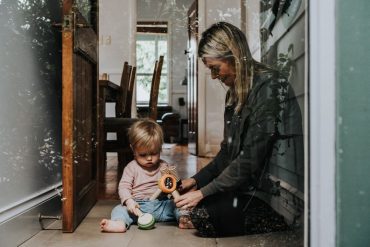7. Coach your child to express her needs and stand up for herself in social situations
All children need the confidence that they can handle what comes up when parents aren’t around. For instance, every child needs to know how to respond to affronts with phrases like “It’s my turn now…. I was still using that….. I don’t like it when you say that…. I am not going to play with you if you say hurtful things to me”. This is especially important when peers tease or bully.
How do you coach your child? Roleplaying is essential in learning skills. Play is very helpful in managing anxiety. Reading books helps teach kids that they aren’t alone or powerless. Asking “What would you do?” is invaluable in helping kids think through possible responses and outcomes. You may also want to read the article 12 Ways to Empower Your Child Against Bullying, which has more specific suggestions and book recommendations.
8. Don’t label your child as shy
Instead, acknowledge his worries and point out that he can overcome his fears. For instance,
“Sometimes it takes you awhile to warm up in a new situation. Remember Lorenzo’s birthday party, how you held my hand all through the games? But by the end, you were having lots of fun with the other kids”.
9. Teach your child effective strategies for dealing with feelings of social awkwardness
One very helpful approach to social anxiety is to accept it as a part of normal life that affects most people. Then, reassure yourself that you’re okay, and focus on others rather than yourself. For instance, reassure your child that most people feel socially awkward at least sometimes. Then remind your child that she doesn’t have to be interesting, just interested, and teach her to ask other kids questions and listen to their answers. Brainstorm with her how she might handle a situation that makes her nervous:
“If you feel nervous at the party today, what could you do to make yourself more comfortable? Could you hang out with one of the kids you know from school? Could you offer to help serve the refreshments? What could you say to reassure yourself? What do you think you might talk with the other kids about?”.
Once she knows she can handle whatever comes up, she’ll feel more ready to tackle a new experience.
10. Help your child develop social confidence by providing small daily opportunities to interact with others
Socially anxious children need downtime, of course, especially if they’re introverts. But they also need plenty of opportunities to practise their social skills. Remember that empathising doesn’t mean being over-protective. If your child is worried, remind him that he can do hard things. Talk every night at dinner about one hard thing each person in the family did that day. Applaud every little step your child takes on his own.
11. Don’t push your child to perform
Some children like telling jokes or showing off their new abilities for Grandma, but many kids hate it. Enjoy your unique child without making him feel like he’s only valued if he performs. If you have the video rolling on your phone and your child asks you to stop, stop. She’s allowed to enjoy life without feeling the pressure to perform.
12. Remember that one good friend is worth many acquaintances
Some parents worry if their child isn’t the life of the party. But what’s important is that your child feel connected, like she has someone she can talk to, or someone he wants to play with at recess. It’s not necessary to have a lot of friends, just a few good ones.
13. Don’t create social anxiety by teaching young children to be afraid of strangers
Instead, teach your child that he or she should always be with you, or with a teacher or trusted babysitter. If her special adult is with her, your child doesn’t need to be afraid of strangers. Once she’s old enough to begin walking home from school by herself, you can begin discussing how to keep herself safe.
14. If your child seems generally fearful, consider that she’s got some tears and fears inside that need to be expressed
When kids experience something scary and don’t feel safe at that moment, the fears get repressed. You can think of this as stuffing them in an emotional backpack, to be processed later. The problem is that humans don’t willingly subject themselves to scary feelings. So often those tears and fears stay locked up inside. But since the body knows those emotions need to be felt to go away, the feelings are always trying to bubble up to get healed. Children who are trying to keep fear at bay often become generally fearful and even rigid. If this describes your child, give her daily opportunities to giggle by playing games that dance just on the edge of fear — bucking bronco rides, for instance. That takes the edge off anxiety. And when she feels safe enough to let those fears surface in tears, welcome her meltdown. On the other side of it, you’ll have a less fearful, more flexible child.
Additional Resources:
Don’t miss our new mini-course Helping Your Child with Anxiety, which gives you two audios and three pintables that guide you through the steps to teach your child (and yourself!) how to manage anxiety.
Originally published here.
Dr. Laura Markham is the founder of PeacefulParentHappyKids.com and author of Peaceful Parent, Happy Kids, Peaceful Parent, Happy Siblings and her latest book, the Peaceful Parent, Happy Kids Workbook.










